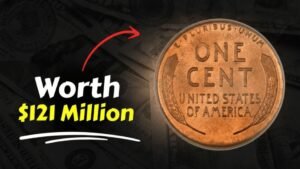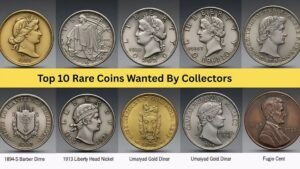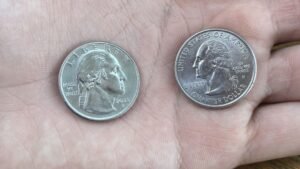Imagine fishing a dusty penny from your jeans and discovering it’s worth more than a luxury car—maybe even a mansion. That’s the wild allure of the rare 1943 Copper Lincoln Wheat Penny. Born from a WWII blunder, this tiny coin could fetch up to $2.65 million at auction. In this post, we’ll uncover its backstory, why it’s a collector’s holy grail, and how you might snag one from everyday change. Ready to turn spare change into a windfall? Let’s dive in.
Introduction to the Lincoln Wheat Penny
The Lincoln Wheat Penny hit U.S. pockets in 1909, honoring Abe Lincoln’s 100th birthday. Victor David Brenner designed it with Lincoln’s profile on the front and wheat stalks on the back—symbolizing prosperity. Minted until 1958, these “Wheaties” are everyday icons. But one version? A total game-changer.
The Wartime Mix-Up: How the 1943 Copper Penny Was Born
World War II changed everything. In 1943, the U.S. Mint ditched copper for steel pennies to save metal for bullets and shells. Billions of shiny steel cents rolled out. But oops—a handful of leftover copper blanks slipped into the mix. These rogue 1943 Copper Lincoln Wheat Pennies? Total accidents. Only about 20 exist today, making them numismatic dynamite.
Why This Rare Penny Commands Millions Today
Scarcity drives the price tag. In a sea of common steel siblings, the copper version screams “error coin.” Collectors crave its wartime tale and pristine condition. High-grade examples shine like new, boosting value sky-high. It’s not just money—it’s history you can hold. For hobbyists eyeing Lincoln Wheat Penny treasures, this one’s the ultimate score.
Hunt for Treasures: How to Spot a Valuable Lincoln Wheat Penny
You don’t need a metal detector—just sharp eyes. Check your jar of loose change. Focus on 1943 dates. Copper glow? Magnet test fail? You might have a winner. Engage by joining coin clubs or apps like CoinSnap. Benefits? Fun hunts, potential payday, and bragging rights. Start small—sort Wheat Pennies from grandma’s attic.
| Identification Step | What to Check | Quick Tip |
|---|---|---|
| Date | Must say 1943 | Ignore steel ones—they’re common. |
| Color | Reddish-brown copper | Steel looks silver-gray. |
| Magnet Test | Doesn’t stick | Copper repels; steel attracts. |
| Mint Mark | Below date (D, S, or none) | Philadelphia (no mark) is rarest. |
| Condition | Minimal wear, sharp details | Pristine = premium price. |
Mind-Blowing Facts and Auction Records
Did you know? A 1943-D sold for $1.7 million in 2010. Another hit $2.65 million in 2019—enough for a yacht! Fewer than 20 verified coppers roam free. Stats show Wheat Pennies average 1-5 cents, but errors? Life-changing bucks.
| Rare Lincoln Wheat Penny | Estimated Value Range | Notable Sale |
|---|---|---|
| 1943 Copper (Philadelphia) | $100K–$2.65M | $2.65M (2019) |
| 1909-S VDB | $700–$3K+ | $168K (2009) |
| 1914-D | $400–$5.5K+ | $159K (2018) |
| 1955 Double Die | $1K–$15K+ | $125K (2009) |
| 1922 No D | $500–$2.5K+ | $78K (2016) |
Expert Tips for Aspiring Coin Hunters
Pros say: Always authenticate via PCGS or NGC—fakes lurk. Store in albums, away from air. Hunt estate sales for overlooked gems. Dive into books like “The United States Mint” for deeper lore. Remember, patience pays. Your next find could rewrite your story.
Frequently Asked Questions (FAQs)
Q: Is the 1943 Copper Lincoln Wheat Penny really still circulating?
A: Yes—most known ones were found in change jars decades later.
Q: How do I sell a rare penny?
A: Get it graded, then hit auctions like Heritage. Expect fees, but rewards rock.
Q: Are other Wheat Pennies valuable?
A: Absolutely—check for errors like double dies. Most are cheap, but rarities shine.
Q: What’s the most expensive Wheat Penny ever?
A: A 1943 Copper at $2.65 million. Wild, right?
Q: Can kids start collecting Lincoln Wheat Pennies?
A: Totally! It’s budget-friendly and builds skills. Grab a starter kit online.
Wrapping It Up: Your Pocket Could Hold Numismatic Gold
The 1943 Copper Lincoln Wheat Penny isn’t just a coin—it’s a wartime whisper worth millions, proving treasures hide in plain sight. From its accidental birth to auction glory, it captivates collectors and dreamers alike. Key takeaway? Inspect that change jar today. Who knows—you might unearth a fortune. Share your finds in the comments, subscribe for more coin tales, or explore our guide to [valuable pennies in circulation]. Happy hunting!




